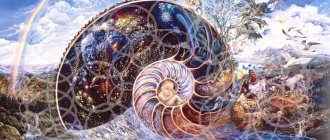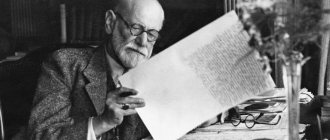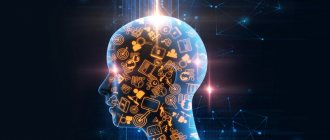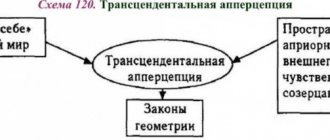The unconscious is interpreted in psychology as mental processes and phenomena, the actions of which are not controlled by human consciousness. The idea of the unconscious was originally put forward by Plato in his doctrine of cognition-memory. This problem was also studied by R. Descartes, who believed that consciousness is the only form of human spiritual life.
Further study of the unconscious was based on the recognition of its role in revealing the characteristics of human development, but no approaches to understanding the unconscious, revealing its features and patterns were proposed.
A new era in the study of the phenomenon began with the emergence of the works of S. Freud, who is considered the founder of psychoanalysis and the systematic study of the unconscious.
Definition
The history of the appeal of past thinkers to the problems of the unconscious begins in ancient times. Even ancient Indian scientists were confident in the existence of an “unreasonable soul,” explaining feelings beyond the control of man. Buddhist teaching also recognizes an area of the mind that is not conscious, but actively influences a person's life.
Ancient Greek scientists defined the unconscious as uncontrollable drives and unconscious knowledge of a person that are beyond the control of the individual. A prominent representative of this period is Plato, who believed that man has an “animal-like beginning” that can take a person anywhere.
In the philosophy of the 17th-18th centuries, the primary task was to comprehend and understand the nature of the psyche and its components, its influence on human life. An important issue of this period was the definition of the unconscious, the features of its role in a person’s conscious life. R. Descartes interpreted this issue unambiguously: there cannot be unconscious processes in the human psyche.
Spinoza, speaking out against the absolute power of the rational, assumed that a person’s deepest drives and desires determine his essence. Spinoza's reasoning, as well as the ideas of the philosopher Hume, who also recognized unconscious processes and did not believe that a person conforms all his thoughts to reason, were later expressed in the works of S. Freud.
The problem of the unconscious was also touched upon by many philosophers of the 17th - 18th centuries (Leibniz, Kant, Fichte), who reflected the features of the phenomenon in their works, largely intersecting with Freud’s idea of the unconscious. For example, Fichte defined the unconscious as the original basis of human existence and the material from which conscious activity is formed.
In the 19th century, one can note the emergence of an irrational understanding of human existence. Outstanding philosophers of this time were Arthur Schopenhauer and Nietzsche, whose works would significantly influence psychoanalysis in the future.
Schopenhauer believed that human conscious actions are incidental and have no representation for knowledge, since the beginning of all things is the unconscious “world will,” which Nietzsche also agrees with.
He considered the unconscious to be the main material for understanding a person and his activities. For Freud, the unconscious is, first of all, a psychological component that is subject to analysis and comprehension only in interaction with a person.
Freud believed that the unconscious includes a set of repressed desires of a sexual nature that cannot be fulfilled in real life due to social norms and values.
Subsequently, Carl Gustav Jung, until a certain time a friend and colleague of Freud, put in the foreground not repressed desires of a sexual nature, but the unconscious, which depends on the theory of archetypes and has several levels. Also, psychiatrist Alfred Adler criticized Freud and replaced the dominant of the sexual and unconscious with a social factor.
Modern ideas about the phenomenology of the unconscious argue that the social conditions of a person’s existence influence both his conscious processes and the unconscious sphere of the psyche. It plays an important role in human activity and is a specific phenomenon that is closely related to social life and the surrounding human reality.
Historical summary
The first mentions of the area of the unconscious, the processes that it contains, can be found in the works of Plato, namely in the doctrine of cognition-memory. This concept underwent fundamental changes after the publication of work on the study of consciousness by R. Descartes. He believed that beyond consciousness there could only be physiological, but not mental, activity of the brain.
The concept of the unconscious was first formulated by G. Leibniz in his work “Monadology”, published in 1720. He argued that it is precisely this that is the lowest manifestation of mental activity. In his opinion, this area is located on the border of conscious ideas.
An attempt to make an accurate materialistic description was made by D. Hartley. He combined the area of the unconscious with the work of the central nervous system.
The incentive for active study of the area of the unconscious, the mental processes that it contains, appeared after many successes in the study and development of psychopathology. To work with patients, specific techniques were used, with the help of which scientists influenced the area of the unconscious. A striking example is hypnosis.
Kinds
The components of the conscious and unconscious were determined by Freud on the basis of the components of the psyche:
1. The id is the unconscious instinctive part, which includes the innate aspirations of a person, instinctive and irrational impulses of the psyche. Most often they include sexual desires.
2. Ego is the part of the personality responsible for making decisions, which appears only as a result of the conflict between the Id and Superego and ensures their interaction.
3.Superego is an unconscious part that includes a person’s highest value system. It is acquired in the process of assimilation of rules of behavior and social norms. This also includes family prohibitions that cause feelings of guilt and fear in a person.
According to Freud's theory, the id and superego are in conflict between instinctual drives and social prohibitions, which do not allow unconscious impulses to be realized in reality. These impulses, after repression, can manifest themselves in the form of somatic or mental symptoms.
Unconscious aspirations can manifest themselves in the form of:
- reservations;
- typo;
- cases of forgetting people's names;
- actions that a person is not aware of;
- dreams that haunt a person. The psychoanalyst considered dreams to be messengers of the unconscious, filled with important symbolism.
Carl Jung, Freud's student and follower, considered his mentor's discoveries the basis for further expansion of his theory. Sigmund Freud placed the unconscious within the framework of the individual, highlighting 3 components of the psyche, when Jung distinguished the concepts of the collective and individual unconscious.
According to this idea, the collective type of unconscious is common to all humanity, uniting many people.
The collective unconscious in a culture manifests itself in the form of archetypes, which are common symbols that are significant for any people, regardless of the cultural factor. The collective unconscious, according to Jung, is a prerequisite for each individual psyche. Processes of “psychic penetration” occur all the time between an individual and other people.
The individual unconscious includes products of instinctive processes, information repressed from consciousness, as well as facts of a creative nature.
Jung said that the personal unconscious will be distributed in an organized manner depending on complexes, emotionally charged thoughts. These complexes are not pathological; their knowledge contributes to the enrichment of the individual and its growth and development.
Results
So, according to Freud, the unconscious is a mental phenomenon universal for every person, which largely determines his behavior. It is also a source of mental disorders.
The Austrian psychiatrist defined the concepts and types of the unconscious - the Id and the Super-Ego. The second has a much stronger impact on a specific person, since it is his individual unconscious.
Subsequently, Freud's students developed the concept of personality structure. It became clear that there are much more types of the unconscious than the discoverer of this concept assumed. Post-Freudianism and neo-Freudianism acquired a large number of followers - Jung, Adler, Fromm, etc.
Freud's theory is still discussed and criticized today. But it is impossible to deny that it had a large-scale influence on the development of science and philosophy of the 20th and 21st centuries, and in particular on the study of the psychology of the unconscious.
Levels
The ideas of Freud and Jung made it possible to expand the idea of the unconscious through the efforts of the Italian psychologist and psychiatrist Roberto Assagioli (1888 - 1974). Based on his research, a new discipline emerged - psychosynthesis. Roberto presented in his work three main levels that demonstrate the unconscious in human psychology.
Levels of the unconscious in psychology
| Level | Characteristic |
| Lower | Includes the simplest forms of mental activity. With their help, the individual controls:
|
| Average | The content of the level includes elements that freely penetrate into consciousness in a person’s waking state. The average level of the unconscious determines the development of mental activity, increasing the possibilities of fantasizing and assimilating the experience gained. |
| Higher | Defined as the superconscious level. Thanks to it, the following appear:
|
Philosophers' opinion
Not only psychology examines the nature of the individual. Since ancient times, thinkers have tried to unravel the essence of people. In dualism, it was believed that consciousness is spirit, and it is immortal and complements matter (body).
J. Berkeley considered consciousness to be primary, and all objects of the material world to not exist outside of perception. F. Engels had a slightly different opinion: consciousness is inherent only to people, and it reflects the world around them.
In philosophy, too, there is no consensus on the meaning of the term
In religion, such concepts are considered from different points of view. In Buddhism, it is believed that consciousness is the entire world around us; in Hinduism, this is understood as the existence of a certain entity that observes the actions of all people.
Functions and role
The unconscious in psychology is, according to Freud’s views, the basic drives and desires of a person:
- reproduction;
- desire for power;
- desire to have fun;
- desire to avoid feelings of fear.
The inability to satisfy one's desires gives rise to conflict at the unconscious level of a person, which is expressed in strong emotional stress.
To avoid it, the Ego performs the following functions at an unconscious level:
- Negation. It consists of not accepting unwanted information.
- Crowding out. It consists of replacing unacceptable information with acceptable information (for example, blaming others for their inability to carry out any activity themselves).
- Projection. Characterized by unconsciously imparting one's feelings to another person.
- Identification. It consists of unconsciously transferring onto oneself the feelings and qualities of another person (for example, relying on authority, parents).
- Rationalization. Finding a more acceptable explanation for true desires that eliminates feelings of shame.
- Inclusion. Reducing the significance of the traumatic factor by changing the value system (for example, the belief that if someone is worse off, then one’s own experience does not matter).
- Substitution. Transferring an action aimed at an inaccessible object to an accessible one (for example, transferring anger towards a person by breaking plates).
- Regression. Consists of returning to earlier patterns of behavior (for example, infantilization).
- Reactive education. It consists of transforming a negative feeling into a positive one or vice versa (in this case, the defender is not aware of his initial feelings, which comes from the definition).
- Sublimation. It is distinguished by the redirection of energy into some activity.
The role of the unconscious, according to Freud, is to reduce tension and avoid a person’s internal conflicts due to the inability to satisfy sexual desires. For example, libido energy, thanks to unconscious processes, can be realized in socially useful activities through the psychological defense of the unconscious - sublimation.
Eros
Eros is a sexual instinct, it is a manifestation of libido. A person, not being in the herd, cannot fully realize all his sexual aspirations. He unwittingly has to suppress them, limiting himself. In a favorable situation, sexual energy will be directed towards creation, creativity, science or political activity.
In other words, in any direction that requires a powerful investment of strength and manifestation of oneself. Sigmund Freud called this displacement of the sexual instinct into another sphere the term “sublimation.”
Forms of manifestations
The unconscious in psychology is a phenomenon that manifests itself in different forms, which determine the following phenomena:
| Name of the phenomenon | Description |
| Unconscious motivations for activity | Includes the attitudes, motives and needs of a person, which are determined by a personally determined image of the desired result. At the same time, a person does not see and is not aware of the connection between his own motives and the events that they cause in the future. |
| Superconscious phenomena | These phenomena are not amenable to conscious-volitional control; they determine the mental level of activity manifested in creative activity. This level includes 2 forms: unconscious (depends on the person’s personal experience, based on existing information) and supraconscious (depends on the person’s personal aspirations to create something new). |
| Subsensory perception | It is a form of direct mental reflection of reality, conditioned by such stimuli, the influence of which a person cannot give himself an account of. This is vaguely conscious sensory data that does not reach the level of consciousness, when analyzers store and record in memory much more information than we are aware of. These may include weak light, sound and other signals that affect a person’s mental state, but are not the subject of conscious attention. These stimuli indicate the reserve capabilities of human senses. |
| Unconscious regulators of ways of performing activities | They include automated stereotypes of behavior and activity. They arise in the process of solving various problems and are based on past experience of behavior in similar situations, pre-setting a person for appropriate actions and thoughts. |
What does mindfulness practice do? Top 7 reasons to start training now
How to train mindfulness, and most importantly, why if you don’t see any prospects in it? Here are seven reasons why you should start working on yourself:
- Success. A person who does his job with full dedication and meaningfulness cannot do it badly. This was confirmed by clinical studies at Harvard Medical School.
- Vivid sensations. The dish tastes much better if you eat it in the kitchen rather than in front of the TV. Sex is more enjoyable if you think about sensations and your partner during the process, rather than about repairs. People are more welcoming if you listen to them rather than look at your phone. The main thing is to turn on at the right time.
- Improved learning ability. Just two weeks of regular practice is enough to “increase” your memory capacity and speed up the memorization of material. Members of the UK Parliament actively use mindfulness training to improve their performance.
- Normal blood pressure and a healthy heart. Respect for one's own body and health motivates people to avoid stressful and unhealthy factors. Realizing the unity of your body and mind is the first big step towards giving up addictions.
- Long life of sound mind. For most people leading a standard lifestyle, speech slows down with age, reactions and perception of reality worsen. It has been scientifically proven that meditation almost halves the rate of cellular aging. Therefore, if you want to feel the same at 60 as you did at 30, practice mindfulness.
- Healthy love and social relationships. Mindfulness will allow you not only to process your own feelings, but also to read the emotions of other people. You will experience empathy, even if it was not characteristic of you before. In addition, you will stop comparing your partner with predecessors and idealizing his image, building unrealistic expectations regarding his person. You will understand and accept it with all its advantages and disadvantages.
- Liberation from fears and phobias. Regular practice of self-awareness helps reduce activity in the prefrontal cortex and amygdala, which are responsible for unreasonable fears. So you will learn to distinguish your suspiciousness from situations where there is a real threat to life.
Working on self-awareness is a good tool for managing your own psyche. People who are fully aware of their own actions are much less likely to suffer from panic attacks, neuroses and depressive disorders.
Psychological theories and schools
The concept of the unconscious in psychology occupied a central place in most schools, finding both supporters (the unconscious exists and this fact must be taken into account) and opponents (there is no unconscious). This sequence of views can be reflected in the form of a table with a brief overview of the interpretation of the unconscious by the main psychological schools.
| School | Key concept | Key concept function | Therapeutic effect | |
| Unconscious | Other | |||
| Freud | Central role | — | The unconscious is a source of energy, a collection of repressed impulses and a generator of symptomatic reactions. | It is necessary to introduce subconscious processes into consciousness in order to change the Id (It) and focus on the Ego (I). |
| cabin boy | Central role | — | The unconscious is the guiding basis of the psyche, the repository of personal memories and imaginative structures of “archetypes”. | There must be a process of individuation that involves the development of a dynamic relationship between the ego and the self. This is the process of spiritual growth of the individual due to the “manifestation” of the deep traits of the subconscious as a result of their assimilation by consciousness. The process of individuation, according to Jung, is driven by a hidden tendency emanating from the spiritual center of human individuation. |
| Behaviorism | Negation | Behavior | Behavior is the basis of personal experience and the source of anticipation and control of activity. | It is necessary to form new conditioned reflexes in order to achieve more adequate or desired behavior. |
| Humanistic | Neutral role | Self-realization | Self-realization is the driving principle of activity and a means of achieving personal integrity. | It is necessary to form the potential of the individual and provide her with the conditions for development, strengthen her innate abilities |
| Cognitive | Neutral role | Cognition | Cognition is the main conductor of a person’s belief system, which determines his experience | It is necessary to change a person’s destructive attitudes and views, to explore his views. |
| Erickson | Central role | — | The unconscious is the repository of human experience, the source of his capabilities and the elimination of symptoms. | It is necessary to activate a person’s unconscious energy to solve an internal problem. |
Mindfulness in Psychology, Philosophy, Religion and Martial Arts
Based on the above, awareness is a concept that is close in essence to mindfulness and concentration. But what distinguishes one from the other? The answer is simple - the level of mental and spiritual development. Even animals are characterized by concentration. For example, predators can stalk their prey for hours, concentrating all their efforts on achieving a simple and understandable goal - satisfying hunger. Service dogs are trained from puppyhood to be alert and can actually recognize familiar smells, commands and gestures.
Animals perform certain actions under the influence of their natural instincts. Human consciousness, like his very existence, is more multifaceted. Let's figure out how self-awareness is interpreted in different teachings.
In psychology
Psychologists are unanimous in their opinion: the central and peripheral nervous systems serve as a kind of filter that sifts out the conscious from the unconscious. If it were not there, then the part of the brain that is responsible for the ability to cognition simply would not have time to digest and sort information received from the outside.
In philosophy
“I think, therefore I am” - this famous saying belongs to the French philosopher Rene Descartes. It was he who first spoke about how important the practice of mindfulness is for a person. The philosopher stated that he experienced a kind of awakening and awareness of his every action, thought and feeling.
In religion
The concept of a mindful lifestyle is most inherent in Buddhism. The development of awareness there is interpreted as spiritual growth and enlightenment. And as you know, an enlightened person is deprived of typical worldly experiences, suffering and dissatisfaction, which are generated due to the discrepancy between reality and the world of illusions.
The role of mindfulness in Buddhism is extremely important
In martial arts
Understanding and being aware of yourself in the present moment is an important skill that is taught in martial arts. The ability to listen to your body and at the same time monitor the actions of your opponent allows you to win and maintain physical health.
The Role of Mindfulness in Martial Arts
Diagnostics
The unconscious in psychology is a phenomenon for the study of which two study methods are used - the method of free associations and the method of dream analysis. The free association method involves a specialist analyzing words continuously produced by the patient. In this case, the psychoanalyst must find a pattern in the flow of a person’s thoughts and identify the causes of his problem.
An association experiment is often used for this method. The procedure for conducting it: subjects are presented with a list of words and told that they need to answer with the first words that come to mind. Typically, each subject is given 100 words and 8 minutes to answer. The results of the experiment allow us to identify the patient’s hidden experiences.
Dream analysis was actively used by Freud, who believed that any dream (mental life during sleep) is an illusory fulfillment of a person’s desire, which he does not have the opportunity to fulfill in reality. This is due to the weakening of conscious control and the release of unconscious processes into dreams.
Freud distinguished two forms of dreams: dreams with explicit content and hidden content. In the first case, the patient sees dream images, a symbolic representation of hidden thoughts. In the second case, thoughts are not shown openly; to analyze them, it is necessary to reveal the full content of the dream and find its hidden manifestations of thoughts.
Most often, in adults, the second form of dreams can be observed, which is associated with protective mechanisms that do not allow openly showing pent-up and unwanted desires even in dreams.
Freud also identified the following manifestations of the unconscious:
- slips of the tongue are an unconsciously determined speech action that is associated with a distortion of the sound basis and meaning of the spoken words. Reservations arise when unconscious intentions and desires collide with consciously determined goals;
- forgetting names is a feature of the unconscious that arises against a person’s will, which speaks of unpleasant feelings towards a person or event in which he appeared;
- automation of movements is a phenomenon of the unconscious, when certain movements were conscious for some time, but, over time, moved into the area of the unconscious. Such movements include walking, reading, speaking.
Concept of the unconscious
To be fair, it must be said that Freud was far from the first to come up with the idea that a person does not fully control his actions, that there is something in him that forces him to act unconsciously or even irrationally. The idea that the basis of many mental disorders was sexual repression was also not new. Freud's aforementioned teacher, the French psychiatrist Charcot, already expressed this idea.
The merit of the Austrian psychoanalyst is as follows. He was the first to say that a person’s consciousness is only a small part of his personality compared to the huge number of unconscious drives. In order to try to understand and cope with them, the help of an astute psychoanalyst is necessary.
Furthermore, Freud argued that these forces were entirely sexual in nature, which he called “libido.” It becomes active, according to the scientist, from the very first years of human life.
Management methods
The unconscious in psychology is a sphere of the psyche, communication with which requires certain skills and practice. There are certain methods that allow you to understand your unconscious or change it.
Affirmation
Affirmation is a short phrase containing a verbal formula, which, when repeated many times, reinforces the required image or attitude in a person’s unconscious. This self-hypnosis technique allows you to determine the vector of your development and get rid of negative attitudes.
It is advisable to write down the invented affirmations on paper and hang them on the wall so that the phrase often catches your eye.
The affirmation should be:
- positive;
- bright and brief;
- capable of motivating and uplifting;
- specific and understandable for those who use them;
- effective so that people believe in it.
Visualization
Sometimes hidden negative attitudes of the unconscious prevent a person from finding himself and achieving his goals. Visualization of desires can effectively solve this problem. Creating a wish map along with creating a positive attitude towards fulfilling them will help you constantly remember your goals, which effectively motivates you to get started.
The wish map is a poster with visualized internal aspirations in the form of pictures, inscriptions and drawings. You should look for them and determine the order of the image in accordance with your feelings, so creating a wish map is an important and difficult psychological task.
Meditation
Meditation is an effective way to develop awareness, which helps to discover new sources of resources, understand your unconscious and change it.
From the first time, few are able to plunge into a state of trance and conduct a meditation session most effectively, but practice and involvement will help a person understand himself and find the strength to change his life towards development. Meditation also helps to overcome stress and improve concentration.
Psychology defines the unconscious as a set of mental processes and phenomena that are not included in the sphere of consciousness of the subject, that is, in relation to which there is no control of consciousness. This part of the psyche plays an important role in a person’s daily life, so it is very important to know about the features of this phenomenon, methods for understanding hidden internal processes and ways to manage them.
Author: Anna Fleyman
First signs
The following are signs that precede syncope:
- causeless anxiety, weakness, incessant yawning, heavy breathing;
- pale skin, sweating;
- headaches that bring a pressing or squeezing sensation, noise in the ears (ringing in the ears may be present), dizziness, hearing problems, suffocation;
- adrenaline rush, accompanied by heat at the end of the fingers;
- darkening before the eyes;
- tonic convulsions;
- a sharp increase or decrease in pressure, heart rate increases;
- nausea, vomiting, sour taste in the mouth.
Fainting is characterized by the presence of the following manifestations:
- the muscles are relaxed and the body is motionless;
- breathing slows down;
- blood pressure decreases;
- in case of deep fainting, the occurrence of convulsions and incontinence cannot be excluded;
- Pupils dilate, in the presence of serious pathologies, there is no reaction to light.
What is mindfulness?
Before we talk about why and how to gain mindfulness, it is worth clarifying what it is. From a psychological point of view, mindfulness is a state in which a person monitors his current experiences, focusing on the present moment and without being distracted by thoughts about the past or future. It represents the ability of consciousness to introspect (internal observation) of its activities. This means that individual experiences are perceived by the person directly and as they are. In most cases, awareness is aimed at internal states, such as intuition or sensory perception of events occurring in the external world.
Philosophy also has a lot of interesting things to say about mindfulness. For example, Rene Descartes, who became one of the first to study consciousness from a scientific point of view, formulated the famous formula “I think, therefore I am.” And by thinking he understood everything that a person does consciously - through introspection. From here we can draw a simple conclusion: man exists, i.e. lives only when he is aware of himself and everything that happens around him.
In addition, religions (for example, Buddhism) and many spiritual teachings also talk about mindfulness. The works of such famous people as Osho, George Gurdjieff, Carlos Castaneda, Jiddu Krishnamurti, Victor Pelevin, Sri Aurobindo, Porfiry Ivanov, Peter Uspensky are devoted to the development of this ability in one form or another. Many amazing books have been written on this topic by world-famous authors (Mark Williams, Danny Penman, Michael Chaskalson, Laurence Levasseur, Richard Moss, Eckhart Tolle and others).
Thus, the topic of awareness worries a huge number of people, and not only those who have devoted themselves to spiritual quests, but also those who simply want to develop and improve their lives, achieve goals and personal growth, to better understand themselves and the people with whom they communicate. . But let's talk in more detail about whether it needs to be developed at all and what it gives. You can start with this video.
Unconscious automatisms
The processes included in the subclass of unconscious automatisms are of a dual nature:
- never realized before (fundamentally not realized),
- once conscious, but at the moment occurring automatically (skills).
Examples of fundamentally unconscious ones: a child’s sucking movements, blinking, eye convergence, grasping objects, walking and much more. Examples of skills: playing a musical instrument, writing, speaking a foreign language, and an endless number of other skills.
It is worth noting that psychologists distinguish in the structure of consciousness:
- focus of consciousness (the most important thing at the current moment in time),
- periphery of consciousness (weak control by consciousness is exercised),
— the boundary of consciousness (the processes located here can either leave the field of human consciousness or enter it),
- unconscious.
Developed skills usually “balance” on the border of consciousness. If a person begins to make a lot of mistakes (when tired, for example, or when the activity becomes more complicated), then the skill again falls into the field of consciousness, to its periphery or even into focus. The skill is controlled, improved, and then returns again to the border of consciousness. This is what distinguishes skills from fundamentally unconscious processes, in that they “wander.”
Various examples of automatisms:
- when reading any text fluently, we do not think about the outline and meaning of individual letters, but “immediately” perceive the meaning of what we read,
- a radio operator working with Morse code, perceiving the sound of short and long signals, completely freely translates them into a logical combination of letters and words,
— entering a dark room, the hand “itself” reaches for the switch.
Brief conclusion
From everything described, it becomes obvious that the life you now have, you created for yourself, thanks to your thoughts. After all, people think with their minds, and all thinking habits are transmitted automatically, after which the subconscious remembers them. Therefore, if you write down all your dreams and goals on a piece of paper and review them every day, this will help you achieve success slowly but surely. After all, the human mind works along one trajectory: if the thoughts are good, they will lead to a prosperous life, and if they are gloomy and bad, they will create the most problematic life. You need to mentally imagine events that you have been waiting for a long time, the subconscious will automatically fulfill this request.
We feel our subconscious through intuition and trance; this is where our memory, sensations and experiences are located. The subconscious can give a person the gift of telepathy and clairvoyance, as well as other superpowers. But the human consciousness and subconscious helps people navigate space and time. A conscious person has knowledge about himself and about space, but here is what he can have:
- pure consciousness and subconsciousness;
- bad consciousness;
- be unconscious;
- to be obsessed with something.











